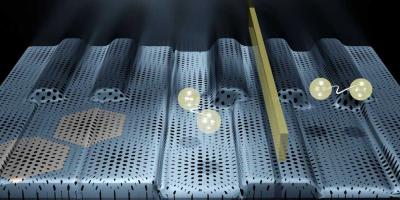Researchers at ETH Zurich, led by Klaus Ensslin and Thomas Ihn at the Laboratory for Solid State Physics, have succeeded in turning specially prepared graphene flakes either into insulators or into superconductors by applying an electric voltage. This technique is even said to work locally, meaning that in the same graphene flake regions with completely different physical properties can be realized side by side.
 The material keyboard realized by the ETH Zurich researchers. Image by ETH Zurich/F. de Vries
The material keyboard realized by the ETH Zurich researchers. Image by ETH Zurich/F. de Vries
The material Ensslin and his co--workers used is known as Magic Angle Twisted Bilayer Graphene. The starting point for the material is graphene flakes - the researchers put two of those layers on top of each other in such a way that their crystal axes are not parallel, but rather make a magic angle of exactly 1.06 degrees. That’s pretty tricky, and we also need to accurately control the temperature of the flakes during production. As a result, it often goes wrong, explains Peter Rickhaus, who was involved in the experiments.
Ensslin and his colleagues are now going one step further. By applying different voltages to the individual electrodes they turn the magic angle graphene into an insulator in one spot, but a few hundred nanometres to one side it becomes a superconductor.
When we saw that, we obviously first tried to realize a Josephson junction, says Fokko de Vries, a postdoc in Ensslin's laboratory. In such junctions two superconductors are separated by a wafer-thin insulating layer. In this way, current cannot flow directly between the two superconductors but rather has to tunnel quantum mechanically through the insulator. That, in turn, causes the conductivity of the contact to vary as a function of the current in a characteristic fashion, depending on whether direct or alternating current is used.
The ETH researchers managed to produce a Josephson junction inside the graphene flakes twisted by the magic angle by using different voltages applied to the three electrodes, and also to measure its properties. Now that that’s worked as well, we can try our hands at more complex devices such as SQUIDs, says de Vries. In SQUIDs (superconducting quantum interference device) two Josephson junctions are connected to form a ring. Practical applications of such devices include measurements of tiny magnetic fields, but also modern technologies such as quantum computers. For possible uses in quantum computers, an interesting aspect is that with the help of the electrodes the graphene flakes can be turned not just into insulators and superconductors, but also into magnets or so-​called topological insulators, in which current can only flow in one direction along the edge of the material. This could be exploited to realize different kinds of quantum bits (qubits) in a single device.
So far, however, that’s just speculation, Ensslin says. Still, he is enthusiastic about the possibilities that arise from the electrical control even now. With the electrodes, we can practically play the piano on the graphene. Amongst other things, the physicists hope that this will help them to gain new insights into the detailed mechanisms that bring about superconductivity in magic angle graphene.